The finish on a piece of wooden furniture, whether this is antique or modern, can make the difference between a charming part of your interior or an eyesore in need of rejuvenation. However, it does not only affect the visual appearance – wooden designs which are left unwaxed or without the correct upkeep can be far more susceptible to environmental deterioration and water damage. Good traditional furniture finishes on a table, chair, or cabinet can survive for much longer than one which has a raw or worn down surface on display.
 Above: our furniture expert treating a cabinet in our restoration studio
Above: our furniture expert treating a cabinet in our restoration studio
In some cases, traditional care may need to be completed by a restoration expert, before returning home to have a light amount of routine upkeep. This is the case with wooden items which show signs of severely worn down areas, lifting veneers, broken parts, cracks, or warping. It is recommended that furniture showing any vulnerability or exposed wood grain is professionally assessed and restored before any amateur cleaning or polishing takes place, so as not to make the deterioration worse. If the furniture is in fine condition and simply requires upkeep, there are several methods available for traditional care at home.
 Above: a selection of antique wooden furniture including a dressing table, a small cabinet and a gothic Windsor armchair all from the 18th century
Above: a selection of antique wooden furniture including a dressing table, a small cabinet and a gothic Windsor armchair all from the 18th century
With many products available to buy from supermarkets and specialist vendors, it can sometimes feel overwhelming when deciding how best to care for a valuable or much-loved piece of furniture. This article will cover some of the many finishes which can be completed by our experts, as well as those which can be performed at home.
 Above: lacquer being applied to a wooden surface – the correct finish can enhance the woodgrain and original details
Above: lacquer being applied to a wooden surface – the correct finish can enhance the woodgrain and original details
Historically accurate wood stains
Staining is the act of colouring the wooden base to a desirable shade. Just like paint, this requires a pigment which historically has been sourced from both botanicals and minerals. The pigment or colour is carried into the wood with a solvent.
Typically, staining is not something which should be considered at home – especially if the furniture is highly valuable or an important family piece. This is because not all stains available from typical shops are in-keeping with the historical significance of the original, and some may use a chemical base which could deteriorate the wood over time.
 Above: although some marks on wood may not entirely be removed due to their location or depth, a correct finish can help to even out the texture and tone of the surface
Above: although some marks on wood may not entirely be removed due to their location or depth, a correct finish can help to even out the texture and tone of the surface
Wood stains only became mass-produced at the turn of the century, before this many of them were handmade through unusual techniques such as soaking tobacco in ammonia, using darkening tea leaves, and mixing vinegar with oxidising iron nails. If your wooden item has a strong smell of tobacco or iron, perhaps this is why. Today many traditional restoration experts still use the rusty nail technique to get organic results, free from contemporary interference.
 Above: a selection of the traditional finishes used in our studio, as well as the tools and era-appropriate materials
Above: a selection of the traditional finishes used in our studio, as well as the tools and era-appropriate materials
In our studio we use precise colour-matching to meet both the era and original tone of the furniture. A damaged surface can be stripped back before being reapplied with an accurate stain. Our experts pride themselves on historical knowledge and the traditional treatment of furniture in their care. You can learn more about historically accurate restoration here.
French polish vs. commercial polish
Unlike commercial polish, French polishing is a technique rather than a specific product. When you come across a piece of furniture, musical instrument, interior design, or floor with a dramatic high shine, this is often due to the carefully applied french polish which has been built up over time. On some antique items there may have been as many as one hundred layers of French polish applied to gain the eventual finish.
French polish is achieved through the expert application of fine shellac by hand, not using any shortcuts such as a spray varnish or large brush. Our furniture expert applies French polish traditionally with a hand dabber – this is a piece of cloth covering an absorbent material which slowly releases the shellac as he moves it across the woodgrain. To give an even finish white spirit is applied to ensure the polish is levelled.
 Above: a mahogany drop-leaf pembroke table, a maple joint stool, and a 19th century sewing table with measurements on the side
Above: a mahogany drop-leaf pembroke table, a maple joint stool, and a 19th century sewing table with measurements on the side
French polish not only achieves gloss, but brings out the patterns in the timber and the colour of the chosen wood stain. Although it is labour intensive, French polish is highly durable and should survive for many years with little upkeep involved – in many cases it is also highly resistant to scratches, cracks and spillages, giving your furniture an extra layer of protection.
 Above: the process of a table restoration from stripping back the damaged surface to staining and finally a french polish treatment
Above: the process of a table restoration from stripping back the damaged surface to staining and finally a french polish treatment
Commercial polishes come in standard or specialist varieties, but it is worth noting the type of wood you’re facing before any home care begins. Modern and contemporary furniture can in some cases have very convincing wooden surfaces which are in fact faux wood – these could easily be disturbed by furniture polish and certain chemicals, so cleaning with anything other than a dry cloth should be avoided. Solid wood should be tested in a small area before proceeding with caution and home polishing should only take place if the furniture is free from cracks and breakages to avoid any chemicals sinking into the untreated wood beneath.
 Above: a variety of polishes and varnishes are available and may have different techniques for application
Above: a variety of polishes and varnishes are available and may have different techniques for application
Traditional furniture finishes – waxing
Waxing is a treatment which can be completed at home and comes highly recommended by our furniture team. Not only will waxing maintain a shine, but it will also add further protection against moisture, water and environmental damage from mould and humidity levels. Waxing is completed in our studio at the end of a restoration project, but should also be maintained over time as part of routine care and cleaning.
It is important to only use a small amount of wax so as not to build up too much or leave an uneven surface. Swiftly rub a waxed cloth in the direction of the wood grain for the best results and continue this process once a month, or as recommended, to help your furniture build resistance and shine.
How can we help?
If you have a piece of wooden furniture or more unusual wooden items, such as sculptures and decorative designs, our team is happy to help. Our furniture experts offer professional assessments of all varieties and eras, as well as traditional repairs and finishes as required.
To make contact please email us via [email protected] or call 0207 112 7576

 Above: our furniture expert treating a cabinet in our restoration studio
Above: our furniture expert treating a cabinet in our restoration studio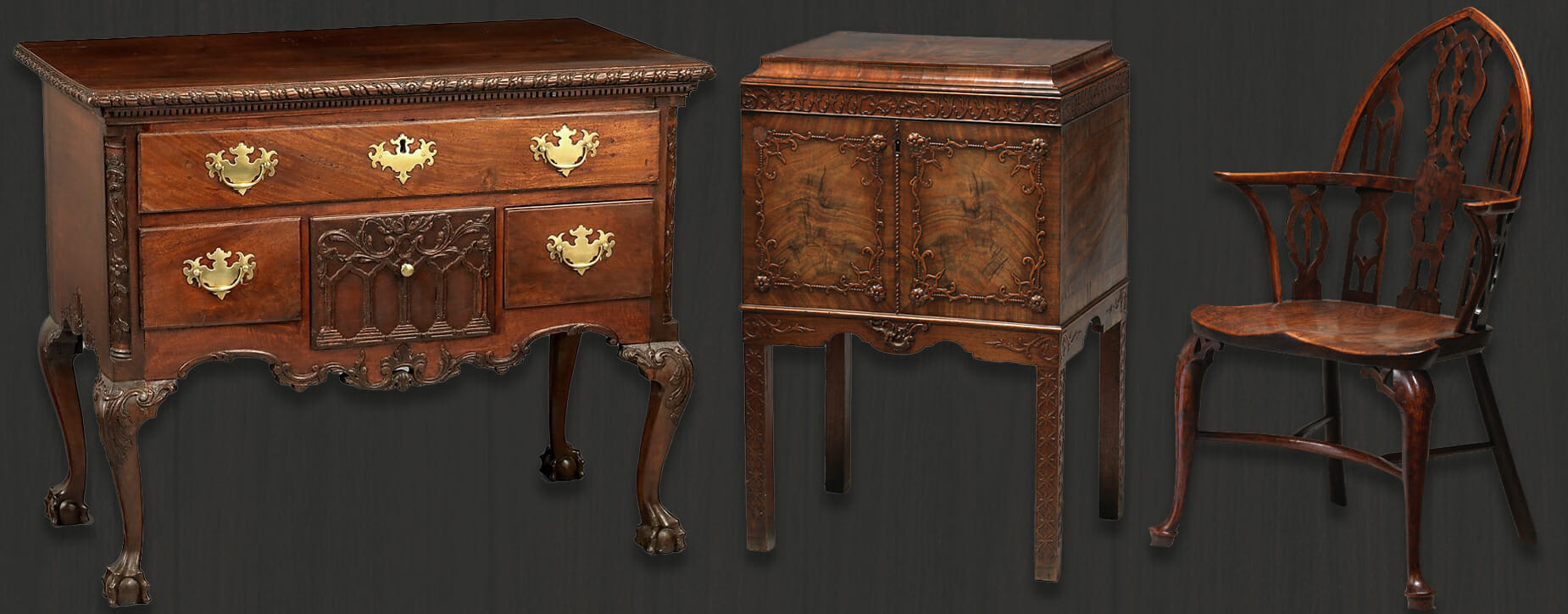 Above: a selection of antique wooden furniture including a dressing table, a small cabinet and a gothic Windsor armchair all from the 18th century
Above: a selection of antique wooden furniture including a dressing table, a small cabinet and a gothic Windsor armchair all from the 18th century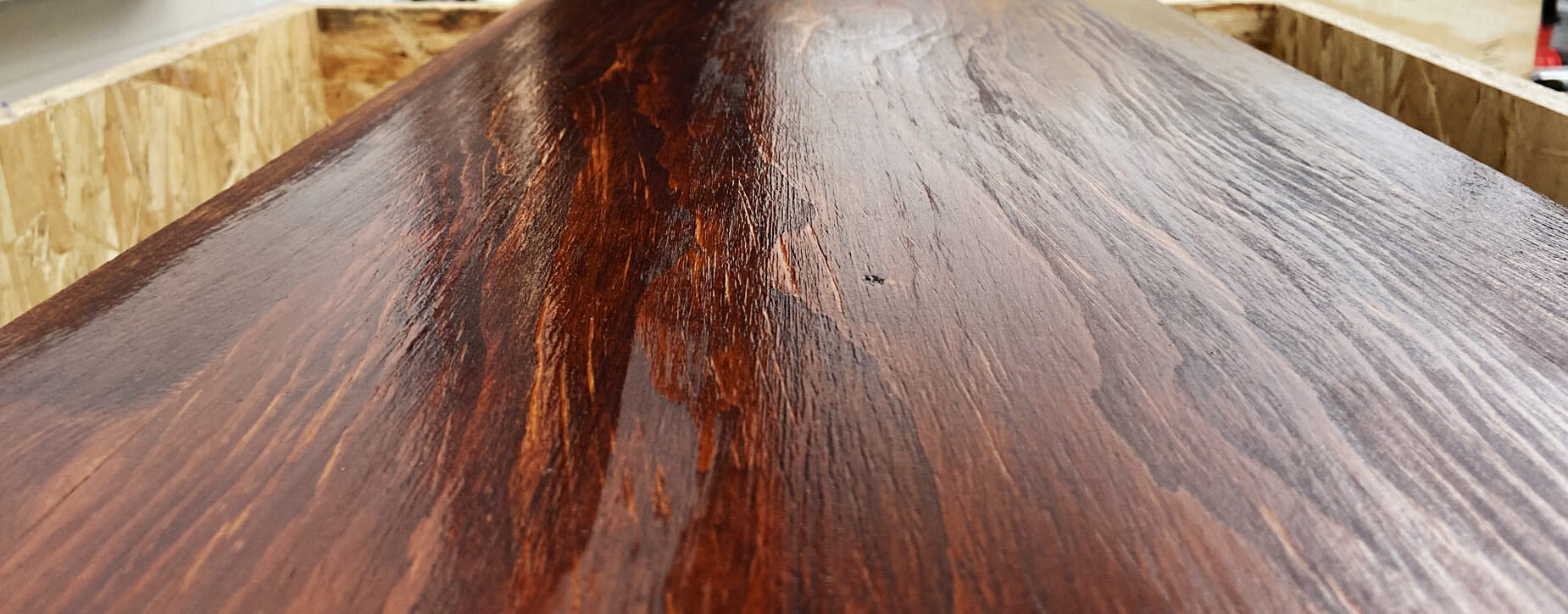 Above: lacquer being applied to a wooden surface – the correct finish can enhance the woodgrain and original details
Above: lacquer being applied to a wooden surface – the correct finish can enhance the woodgrain and original details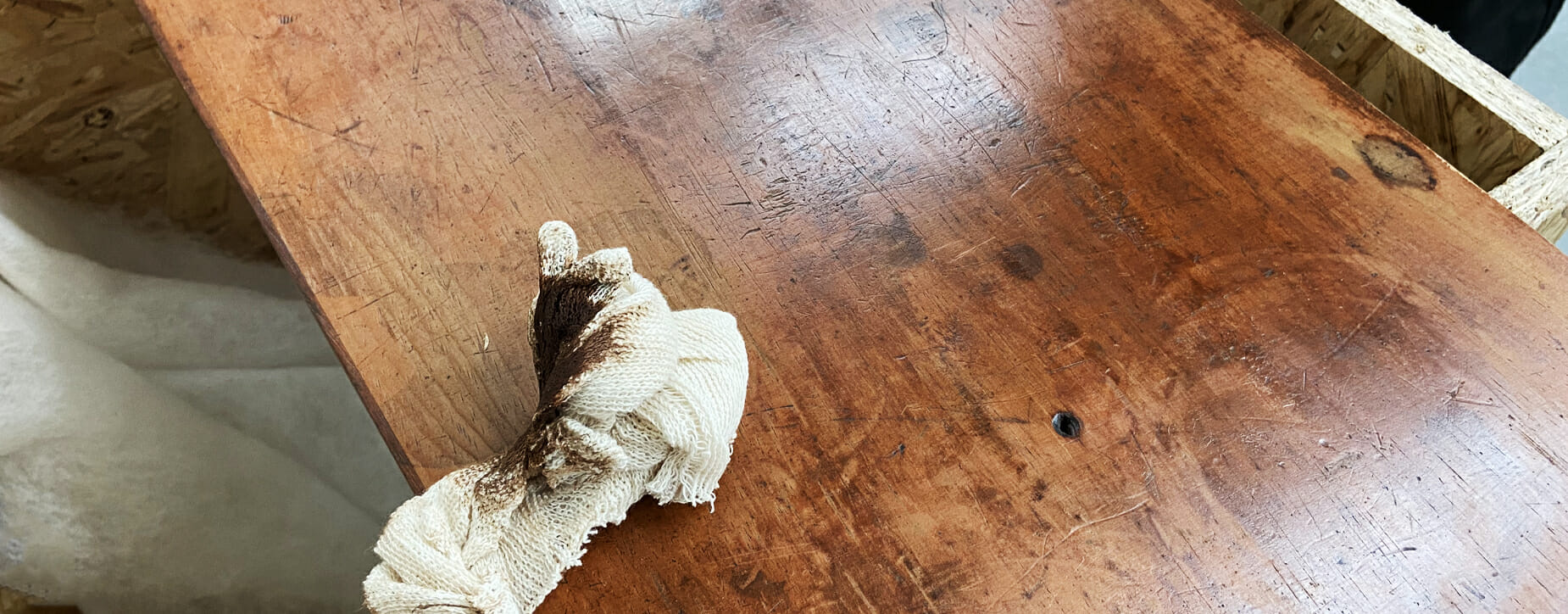 Above: although some marks on wood may not entirely be removed due to their location or depth, a correct finish can help to even out the texture and tone of the surface
Above: although some marks on wood may not entirely be removed due to their location or depth, a correct finish can help to even out the texture and tone of the surface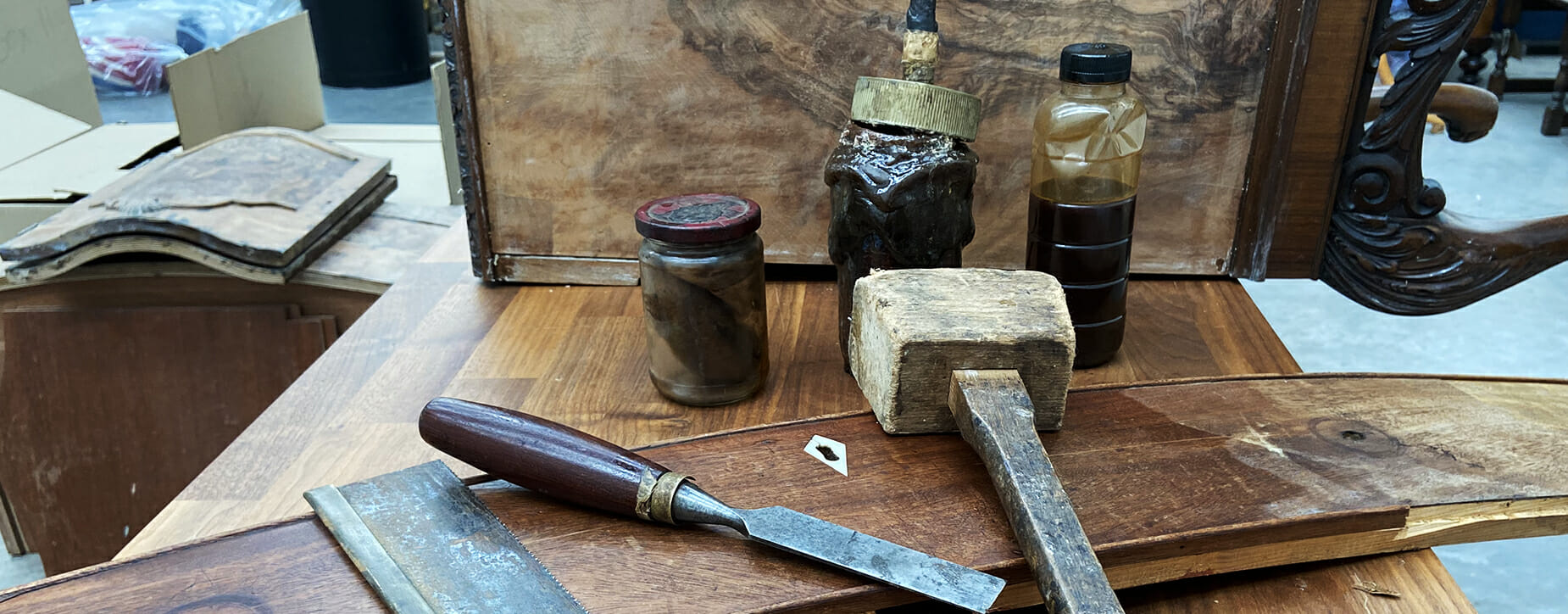 Above: a selection of the traditional finishes used in our studio, as well as the tools and era-appropriate materials
Above: a selection of the traditional finishes used in our studio, as well as the tools and era-appropriate materials  Above: a mahogany drop-leaf pembroke table, a maple joint stool, and a 19th century sewing table with measurements on the side
Above: a mahogany drop-leaf pembroke table, a maple joint stool, and a 19th century sewing table with measurements on the side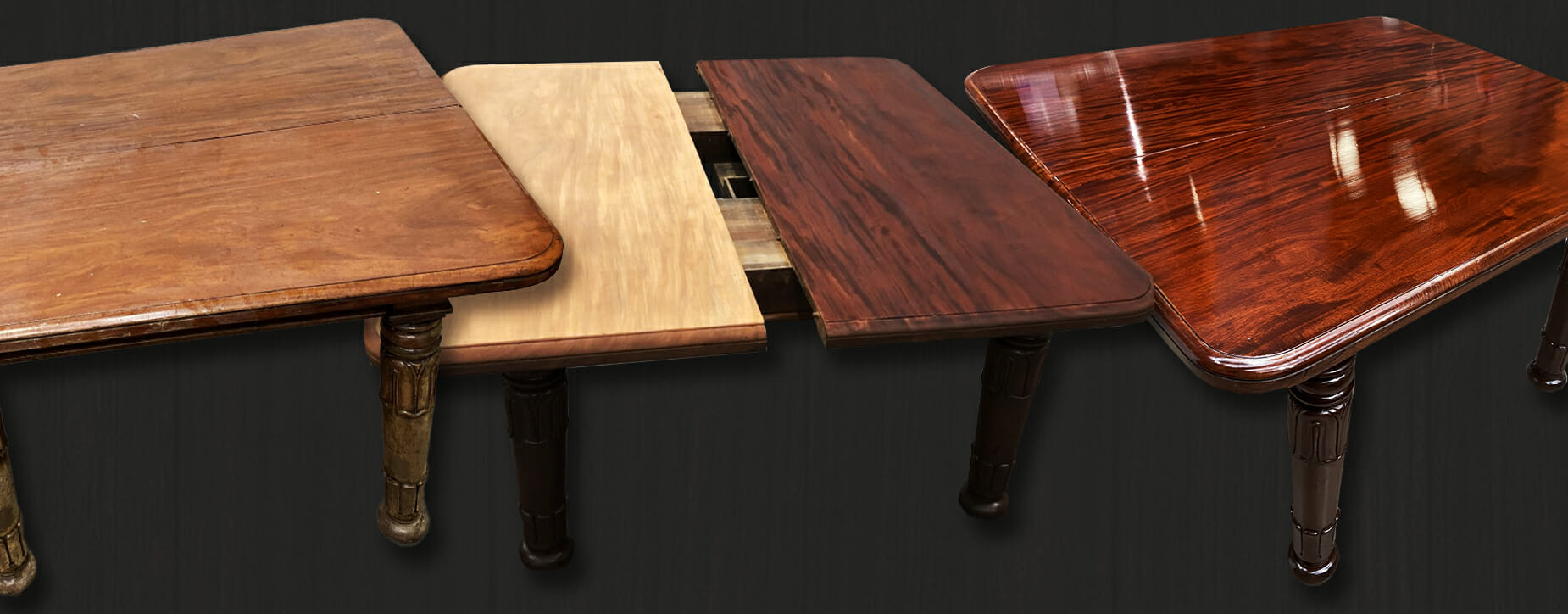 Above: the process of a table restoration from stripping back the damaged surface to staining and finally a french polish treatment
Above: the process of a table restoration from stripping back the damaged surface to staining and finally a french polish treatment Above: a variety of polishes and varnishes are available and may have different techniques for application
Above: a variety of polishes and varnishes are available and may have different techniques for application




